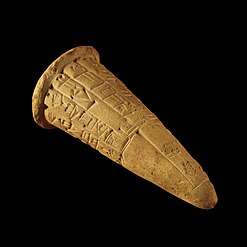Foundation deposits are the archaeological remains of the ritual burial of materials under the foundations of buildings.
- Examples of foundation deposits
-
 Foundation nail dedicated by Gudea to Ningirsu.
Foundation nail dedicated by Gudea to Ningirsu.
-
 Fenestrated silver axehead, Middle Bronze Age, found near Byblos
Fenestrated silver axehead, Middle Bronze Age, found near Byblos
Ancient Egypt

In the case of Ancient Egypt, foundation deposits took the form of ritual mudbrick lined pits or holes dug at specific points under temples or tombs, which were filled with ceremonial objects, usually amulets, scarabs, food, or ritual miniature tools, and were supposed to prevent the building from falling into ruin.
See also
References
- Gerritsen, Fokke Albert (2003). Local Identities: Landscape and Community. Amsterdam University Press. pp. 63–64. ISBN 9789053565889.
- Shaw, Ian (2000). The Oxford History of Ancient Egypt. Oxford University Press. p. 103. ISBN 978-0-19-815034-3.
- "Foundation deposit (Glossary entry)". Theban Mapping Project. Archived from the original on 2016-03-04. Retrieved 2007-06-17.
This article relating to archaeology is a stub. You can help Misplaced Pages by expanding it. |
This article about subjects relating to ancient Egypt is a stub. You can help Misplaced Pages by expanding it. |
